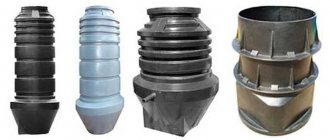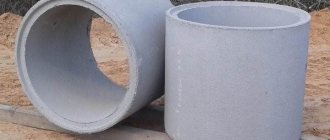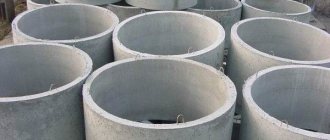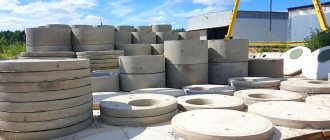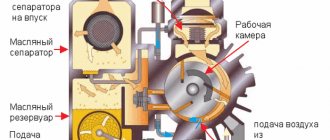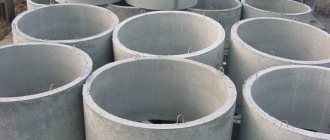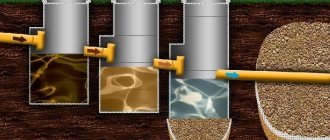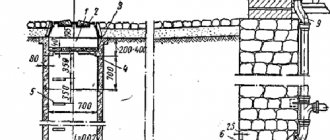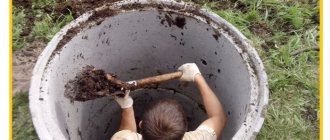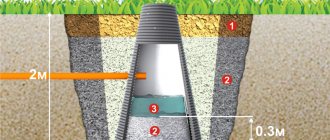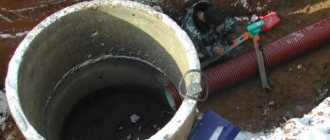It’s hard to imagine a cottage or country house without a well; it’s almost impossible to live even one day without water. That is why, when building a country house, people always include a well in the project. Thanks to it, most of the country turns to water for the winter, because it is one of the few ways to get clean water without a public water supply system. In order for the well to serve for a long time, it is important to think about what it will be made of; plastic rings for sewerage are a modern replacement for concrete ones; in many advantages they even surpass the usual concrete rings.
- 2 Where and how they are used
2.1 Open installation method - 2.2 Closed method
Features of using plastic rings for wells
Separate plastic rings are used to assemble a single well shaft structure. They allow installation work to be completed in the shortest possible time, while reducing overall labor costs by at least half.
In addition, home owners are given the opportunity, with the help of such plastic components, to equip the necessary hydraulic structures in rather difficult climatic conditions, as well as in wet soils, which are subject to deep freezing in winter in regions with low temperatures. Such conditions negatively affect other design options, especially in cases where they are assembled from reinforced concrete rings. Even not very strong movements in the soil layers can contribute to their shift, which can lead not only to damage to the walls and violation of the tightness of the shaft, but also to the failure of expensive equipment installed in the well.
The modern trend in the quick and high-quality construction of various wells is assembly from plastic rings
Depressurization of the walls of a well used as a source of water creates a high probability of its rapid contamination and deterioration, necessitating frequent disinfection. The use of high-quality rings made of plastic solves this problem, since there are reliable ways to connect individual sections into a single sealed structure.
A two-chamber septic tank made of plastic rings - with a sealed container for accumulation and sedimentation of wastewater, and with a perforated one - for removing purified water into the drainage.
Plastic rings are used to equip well shafts intended for the following needs:
- For the construction of a conventional water well, a source of water. Not all ring models are suitable for this purpose.
- For the construction of chambers for local treatment facilities - cesspools and septic tanks.
- For storage wells of storm sewer systems.
Arranging a caisson for a well using plastic rings
- For inspection (inspection) wells at junctions of streams, turns, elevation changes, on straight sections at certain distances, etc.
- Caissons above the well for installing automatic pumping equipment in them, protecting the well from atmospheric pollution.
As you can see, the scope of application is very wide, covering, perhaps, the entire variety of hydraulic structures in a private house.
How to make concrete rings with your own hands
This question is relevant for those who need at least a dozen rings. If 4-5 rings are enough for you for a septic tank or well, then it is better to buy ready-made products and do not engage in manual production. The formwork for such a structure is quite complex to manufacture, and the casting work requires great care. Otherwise, the rings may turn out uneven and weak, with voids in the concrete.
The ratio of components for preparing concrete can be taken as follows: 1 part cement, 1 part crushed stone, 3 parts sand. Add water to the mixer carefully, in small portions. The working consistency of the concrete mixture should be such that it is evenly distributed inside the mold.
Here are the basic technological requirements, without which the manufacture of concrete rings with your own hands will not give the expected quality:
- Durable steel collapsible form;
- High-quality cement (grade not lower than 500);
- Fine aggregate (crushed stone of 5-10 mm “seed” fraction and washed sand);
- Vibration compaction of concrete mixture;
- In the cold season, electric heating.
As can be seen from the figure, the casting mold consists of two half-rings made of durable sheet steel (1.5-2 mm). Stiffening ribs are welded to the ends, and connecting plates are attached along the entire length, which, before concreting, tighten the half rings into a single structure.
Removing the formwork from the outside of the form is easy: unscrew the bolts and tap the walls with a hammer. The inner part is more difficult to remove. Here, to facilitate disassembly, two additional narrow walls or square pipes are placed in the mold.
Having knocked them out, the internal parts of the “shell” are removed from the ring.
Why use fine aggregate for concrete? Because the thickness of a standard ring is small (7-9 cm). It is impossible to pour large crushed stone into the mold, since the structure of the concrete will be uneven.
Vibration compaction also plays an important role. Without it, it will not be possible to remove air bubbles and cavities that reduce the strength of concrete. By bayoneting, the compaction problem can be solved, but only partially. If you do not have a platform vibrator, you can use a regular hammer drill. Instead of a lance, you need to clamp a piece of reinforcement into it with a thick steel plate welded to its end.
Turn on the tool and successively press it from the outside into the lower and upper parts of the mold. The vibration will be transferred through the metal to the concrete. It will begin to settle and thicken.
To lift and lower the rings using a crane, do not forget to install 4 mounting loops (wire diameter 8-10 mm) in the mold. Bend their ends and bury them 40-50 cm into the concrete.
Types of plastic rings
Manufacturing materials, dimensional parameters
As mentioned above, wells can have different purposes, and accordingly, operating conditions will vary. Therefore, for the manufacture of rings for assembling a well, polymers with different physical and operational characteristics can be used.
Both in terms of material of manufacture, and in size, and in the principle of installation, rings can vary quite seriously
The table below will help you figure out which wells are best suited for rings made of one material or another:
| Illustration | Brief description of products and their properties |
| Polymer-sand components are the most popular of all plastic rings, as they are used for arranging almost any kind - sewer storage, rotary, inspection, drop-off and filter wells. They are made from a sand mixture, which makes up 75% of the total volume of material, as well as polymer and dye, which make up 25%. The light weight of the rings allows you to transport and install them yourself. The rings are joined together using the tongue-and-groove principle; before installation, a special sealant is applied to their joints. The material is resistant to high loads, low temperatures and high humidity, and is inert to chemical influences, so rings made from it can be used for the installation of drinking and sewer wells. | |
| Polyethylene rings are highly resistant to low temperatures and are also inert to the aggressive chemical effects of ground moisture. However, this material does not have the most outstanding strength, so rings made from it are most often used as liners in already old wells made of concrete rings. They increase the durability and tightness of the structure. Polyethylene elements are installed both in newly constructed wells and for repairing those that have been in use for a long time. Repairs using such tabs will cost much less. However, you can also purchase high-quality PE rings with thick walls and pronounced rings of rigidity, which are perfect for creating shallow inspection or storage sewer wells, or for caisson equipment. Stiffening ribs will help such a well cope with external soil pressure. | |
| Products made from low-density polyethylene (HDPE) very often have a two-layer structure - an outer dense corrugated casing of a dark color and an inner light layer that smoothes the relief of the corrugation. These products often cannot justifiably be called rings, since they are full-fledged pipes of various lengths. The convenience of using solid pipes for a well lies in the absence of joints, which guarantees complete tightness of the walls. Products made from HDPE are highly durable and designed for a long service life, but the cost of such rings or pipes is quite considerable. Such pipes can be used as an insert in a concrete well during its overhaul, renovation, or used independently, without the use of concrete rings, when constructing a new well. If you need to equip a well for water, you should choose products that have a blue longitudinal stripe along the inner surface. | |
| Polypropylene rings for wells are designed for operation at temperatures from 0 to +95 degrees, and have very poor resistance to ultraviolet rays. And these negative features of the material limit its outdoor use. In principle, there is nowhere for direct sunlight to come from in a well, but the “weakness” to negative temperatures should alert the consumer. However, there are exceptions among polypropylene products. For example, it produces rings from this material that are quite resistant to low temperatures. Polypropylene has good heat resistance (at the upper limit) and wear resistance. Moreover, it is a thermoplastic material, that is, it is possible to ensure the tightness of the created structure by welding the seams between the rings. Rings made of this material can be used to construct caissons, wells for drinking water, drainage or storage chambers. | |
| PVC rings are resistant to ultraviolet radiation, designed for operation at temperatures from -60 to +45 degrees, the material hardness coefficient is SN8, which indicates their increased strength. The durability of the products is estimated at 50 years or more. PVC rings are well suited for arranging sewer wells. A clear disadvantage of PVC products is their low resistance to high temperatures. |
In addition to the material of manufacture, plastic rings can vary significantly in both configuration and dimensional parameters:
- The internal diameter of the rings varies in the range of 400÷1500 mm.
- The outer diameter depends on the wall thickness and the height of the corrugation relief (stiffeners). For products used at the private construction level, it can reach up to 1600 mm. In this case, the pit for installing a plastic well shaft must be dug 150÷200 mm larger than its diameter.
- The height of the rings can range from 200 to 1500 mm (anything larger can most likely be mistaken for a pipe, although there is still no clear “transition boundary” between these concepts). The height of the individual sections and their number are selected depending on the planned structure and the overall depth of the well.
- The wall thickness of products can also vary significantly. Thus, on the thinnest models, a thickness of only 6 mm is found. and for others it even reaches 55 mm. It is clear that this parameter directly affects the mechanical strength of the product. And the deeper the well, the greater the loads it will experience from the outside and inside, the thicker the walls should be chosen.
Expert opinion: Afanasyev E.V.
Chief editor of the Stroyday.ru project. Engineer.
It is clear that the dimensions must be specified upon purchase, including the markings and accompanying documents. There is no single standard in labeling, so it makes no sense to dwell on this. We can only note that diameter and height usually appear.
Practice shows that an internal diameter of 900÷1000 mm is the best option for most wells, both water-bearing and technological, those that have to be descended into quite often. A smaller diameter will be inconvenient when operating the mine. For inspection purposes, for example, in storm sewers, smaller diameters may well be used. True, a lot depends on the performance of the system in this particular area.
How are storm drains planned and calculated?
Stormwater is a rather complex “organism”. And in order for it to work as its owners expect, it is necessary to carefully calculate each of its sections: from areas and points of rainwater collection, to storage collectors or discharge to filtration fields. An approximate diagram, main elements and bridles and methods for calculating storm sewers are in a special publication on our portal.
Additional elements for plastic rings
Almost all companies that produce plastic rings and pipes for constructing or repairing wells also produce additional elements for them. So that you can immediately purchase a complete set with a unified system for pairing and sealing parts.
It is clear that the specification of parts may vary depending on the material of manufacture and model.
Here, for example, is what is included in the main set of parts for a polymer-sand typesetting model:
Polymer-sand kit for arranging a well, which, if necessary, can be supplemented with the required number of rings to achieve the required depth (shaft height).
1 - The sewer manhole (the manhole itself + the ring) for plastic wells can be made of the same polymer. As a rule, the dimensions of the hatch ring are standardized, that is, in fact, even an old cast-iron kit can be used. But there’s no point in loading the well with extra weight - plastic hatches are even more practically and completely safe. It consists of two elements - a ring and a lid.
Plastic sewer manhole - this size standard fits most manhole sets.
2 — The passage under the hatch is often given a conical shape, which is ideal for draining rainwater from the shaft and for constructing a clay castle.
By the way, the transition to the hatch can be of a different type - with an elongated neck, which allows you to place the well (chamber) deeper from the ground surface and narrow the entrance to it. Such measures are often very justified to protect the well from freezing in winter.
The illustration shows a telescopic extension that allows you to precisely adjust the installation height of the hatch.
Such an extension often has a telescopic design, which allows you to set the desired height of the neck, that is, accurately adjust the position of the hatch. It is very convenient during installation - you don’t have to be afraid to make a small error when installing the main structure - you still have the opportunity to position the hatch unnoticeably, flush with the ground surface.
3 — The rings that make up the well shaft. They can have different heights, depending on the material of manufacture. The walls of rings or a solid pipe can be smooth, have stiffening ribs or corrugated relief, sometimes they have ready-made or marked windows for pipe entry that require subsequent cutting. The number and type of rings are selected depending on the required depth and purpose of the well.
4 — The bottom can have different configurations. For example, for sewer wells, various tray options are produced, equipped with several pipe connections. The number, location and diameter of the nozzle may vary. Often, no pipes are used, but only designated areas for cutting out windows, if necessary (by analogy with rings).
Plastic kit for sewer well "Rodlex". The bottom section allows for hermetic insertion of pipes of various diameters.
For some wells, say, for cesspools, for the first (first and second in a three-chamber scheme) chambers of septic tanks, storage tanks, as well as for caissons, solid flat round bottoms are used. And individual hydraulic structures (water-bearing wells or drainage wells, with a filter layer at the bottom) are equipped without any bottom at all.
The diagrams also show O-rings here and there. But these elements are not used in all models, so they may not be included in the kit. And in such cases, other approaches to sealing are used.
Basic methods of connecting polymer well rings
When installing a well shaft from individual polymer rings, several methods are used to connect and seal them
| Illustration | Brief description of the essence of the technology |
| The tongue-and-groove system is the easiest way to connect rings together. But it is successfully used with polymer-sand rings, which still have a certain massiveness, which is necessary for such installation. The scheme is simple - there is a tenon at the lower end of the ring, and a counter groove along the upper edge. That is, everything is elementary - the tenon of the upper next one is inserted into the groove of the installed and aligned lower structural element. If it is necessary to create a guaranteed tightness, for example, in a storage or aquifer well, or in the primary chamber of a septic tank, before installing the next ring, the groove of the lower element is filled with mounting sealant. This, by the way, will add strength to any well, even one that does not require complete sealing. | |
| Threaded connections of parts, from the bottom to the neck and hatch, are provided, for example, in Rodlex systems, as well as in products from other manufacturers. The first lower ring is screwed into the bottom element, then the next ring is mounted into it in the same way, etc. After assembling the shaft, it is closed with a hatch that is screwed into the upper ring. Silicone seals are pre-installed into all connecting nodes. | |
| Bell connection - when a slightly narrowed end of a part is inserted into a slightly widened edge (bell) of the mating element, where the sealing collar is usually located. The principle is the same as that used when installing sewer pipes, only the diameters are larger. The illustration shows a sewer inspection well assembled using the socket principle. | |
| Extruder welding is used to connect rings made of low-density polyethylene or polypropylene. It is carried out from the inside of the structure after completing the installation of parts in the prepared pit. Sometimes welding is also used in a system where the rings are connected with a threaded connection - to give the structure a higher tightness. The work is carried out using a special device - an extruder, which allows you to fill the gaps between parts with a polymer melt. |
Another approach can be used to diffuse welding of polypropylene rings to form a well shaft - using special equipment that ensures the melting of the edges of the parts and their subsequent precise coaxial compression. But such work is carried out before the installation of the well itself, that is, in fact, the customer receives not the rings, but a finished liner, so this is somewhat beyond the scope of our consideration today.
Polymer liners for concrete wells and chambers are an effective solution to old problems!
Reinforced concrete rings are a very convenient material for the construction of wells or local treatment facilities. But they also have certain vulnerable spots that require special attention - aging and erosion of concrete, leakage at the seams between the rings. how to solve these problems using plastic inserts in concrete wells in a special publication on our portal.
Product classification
Based on the technical characteristics, reinforced concrete rings for sewerage are:
- wall (ordinary);
- additional;
- castle;
- supporting;
- rings with a lid or bottom.
Wall ring of reinforced
concrete products Ordinary wall rings are produced without auxiliary fastening elements. They are joined on top of each other, and the joints are protected from water permeability using cement mortar. When choosing these reinforced concrete products for a well, you need to know that the strength of the floor will not be high. Therefore, they are not recommended for installation in seismically active areas.
Prefabricated reinforced concrete elements, unlike wall products, have non-standard dimensions and are intended for atypical structures. To obtain the required size, you simply need to join ordinary products with additional elements. Reinforced concrete locking rings have 4 projections on top and 4 grooves on the bottom. This ensures a tight and stable connection during assembly and prevents the shaft from moving in the horizontal plane.
By filling the grooves in the upper part with cement mortar and laying a rubber seal on top, the tightness of the structure increases. Support rings are needed for the further construction of the hatch and are mounted directly in front of the floor slab. And reinforced concrete products with a bottom or a lid are similar to wall elements, but have, respectively:
- bottom;
- lid.
Dimensions of concrete rings for sewerage, with which products are produced:
- diameter – 700, 1000, 1500, 2000 mm;
- height – 600, 900 and 1500 mm;
- The volume of the product depends on the combination of standard sizes.
Manufacturers also produce reinforced concrete products with custom sizes.
Video: Septic tank made of concrete rings
Selection of questions
- Mikhail, Lipetsk — What discs should I use for cutting metal?
- Ivan, Moscow - What is the GOST for rolled sheet steel?
- Maxim, Tver - Which racks for storing rolled metal products are better?
- Vladimir, Novosibirsk — What does ultrasonic processing of metals without the use of abrasives mean?
- Valery, Moscow - How to forge a knife from a bearing with your own hands?
- Stanislav, Voronezh — What equipment is used for the production of galvanized steel air ducts?
Advantages of prefabricated plastic wells
Each of the polymers used to produce well rings has its own characteristics. However, almost all options also have common positive characteristics that should be highlighted. This may include the following:
- Easy to install the well structure compared to reinforced concrete rings. In particular, there is no need to involve heavy lifting equipment, since literally two or three people (depending on the chosen well option, of course) can easily cope with this work.
- Durability of the structure - plastic does not crumble or collapse as quickly as concrete rings under the influence of moisture.
- The smooth walls of plastic shafts are less susceptible to contamination, build-up, silt deposits or algae. They are easier to clean if necessary.
- No corrosion, since the design does not include metal elements.
- Resistance to low temperatures (not all polymers - this was discussed above).
- Inert to chemicals that may be present in soil moisture or collected runoff.
- Impact resistance, which, by the way, is also important during installation.
- Sealing of connections is easily achieved.
- After sealing the connecting nodes, the structure does not require additional waterproofing either outside or inside.
As you can see, the advantages are significant, and this fully justifies the purchase and use of such kits. Despite the fact that their selling price is much higher than that of “classic” concrete rings.
How high quality products are achieved
The production of concrete rings for sewerage is carried out using a special technique from high-quality material. The optimal grades of cement for mortar are M400 or M500, which ensures the durability of structures. Fine crushed stone, sand and water are also used. The structure is reinforced with a metal mesh along the side surface of the product. Due to the use of reinforcement, sewer rings are highly resistant to mechanical loads.
They are able to withstand various climatic influences and are distinguished by their aesthetic appearance. These reinforced concrete products (RCP) are used for:
- installation of drinking water wells;
- construction of septic tanks and wells for wastewater disposal and sewerage;
- installation of cesspools;
- construction of various underground communications.
Diagram of a septic tank made of concrete rings
Several recommendations for choosing polymer rings for wells
Before choosing and purchasing one or another version of plastic rings, you should consider some recommendations:
- If the choice has already been made in favor of a certain model of polymer rings, then before purchasing them you should independently calculate the required depth of the well, the pit for its assembly, the required number of products to build the well shaft, their dimensions, the thickness of their walls, as well as other parameters of both rings and and additional elements. It is best to draw up a project in which all the necessary quantities will be included.
For example, for a septic tank, the calculation is based on the number of people living in the house and its equipment with plumbing fixtures. It can also be taken into account simply the volume of the storage tank required, say, to store water reserves for various needs.
By the way, if you have to base your calculations on the already known (calculated) volume of a storage well or septic tank chamber, then you can use the following online calculator:
Calculator for calculating the working height of the septic tank chamber and the number of rings for its construction
Go to calculations
It's simple: you substitute known values and get the result. The only important nuance is that it is necessary to calculate the working height of the well, that is, up to the height where the supply pipe or overflow pipe into the next chamber enters the shaft.
Above this point to the surface of the earth there may be the same rings in small quantities or a conical transition to the neck with a hatch.
- If finances allow, then it is best to opt for double-layer corrugated HDPE pipes. They will ensure the absolute tightness of the structure, since it only has a joint with the bottom part. This version of the plastic product is also suitable as an insert when repairing a concrete well.
- When sealing the joints of the rings (if standard seals are not provided there), moisture-resistant sealants or high-quality welding should be used. Otherwise, through the gaps that may form on the seams over time, groundwater will penetrate into the mine, carrying a lot of contaminants, which will inevitably lead to the need to clean and disinfect the well. And this is a very troublesome matter.
What to do if the water from the well becomes unfit for consumption?
Unnoticed errors or simply carelessness during the construction of a well for water supply at home sooner or later lead to the fact that the water becomes completely unsuitable for consumption. What to do? You will have to carry out a procedure for cleaning the shaft, sealing it, and then thoroughly disinfecting the water in the well . Read how this is done in a special publication on our portal.
- Purchased plastic products must have certificates of compliance with all sanitary and technological standards. It is especially important to check the documents when purchasing rings or pipes for constructing a well for drinking water.
- When carrying out installation work, it is imperative to strictly adhere to safety regulations. Even if the well is shallow, only one and a half to two meters, the rings, before handing them over to the receiving master located in the pit, must be tied to a stable, fixed support with a strong rope. This simple device will help prevent injuries, since insurance will be provided by the remaining workers at the top. Even a light object falling on your head from above can cause a lot of trouble. And the weight of some polymer-sand rings reaches up to 50 ÷ 60 kilograms!
Polymers used and their advantages
Modern materials used for organizing sewage systems are as follows:
Polyethylene. The benefits look like this:
- Rings made of this material are designed for use in difficult conditions.
- They can withstand significant temperature changes from -50 to +70 degrees. They are resistant to aggressive environments.
- Modern manufacturing technology is such that it makes it possible to obtain models without seams, which reduces the formation of deposits to zero.
- Sewer rings have different shapes.
- Thanks to multilayering, excellent structural strength is achieved.
- The material allows the septic tank to be used for a large amount of time and in a wide range of climatic conditions.
Polypropylene also has a number of positive qualities:
- The material has increased hardness.
- Abrasion resistant.
- Due to the fact that it can withstand +140 degrees, it can be used at high temperatures.
- Not subject to corrosion and cracking.
- Sewer rings made of this material have shown their reliability when cleaning industrial wastewater when exposed to an aggressive environment.
Fiberglass consists of various types of resins and has the following advantages:
- Thanks to the fiberglass contained in the composition, high strength indicators are achieved.
- Resistant to various aggressive environments.
- Not subject to corrosion.
- There are separation chambers.
An example of installing a well made of polymer-sand rings
This section will discuss the installation of a caisson - under a water supply distribution unit, with the possibility of discharging water into the drainage.
The drainage pipe outlet is intended to drain the water remaining in the pipes above, if the need arises, for example, when preserving the water supply in a country house for the winter. The owner of the site plans to drain the water directly into this inspection well, so the bottom is made leaky, with drainage capacity.
| Illustration | Brief description of the operations performed |
| Work on marking and digging a pit measuring 1200x1200 mm has already begun. The shape is a bit strange, isn't it? The fact is that the Well was initially planned to be square in shape with brick laid and plastered, then with monolithic concrete walls. Both options would be much more expensive and would take more time to complete the work. So, just in time, the owner of the site received a proposal to equip a well using polymer-sand rings. | |
| Having assessed this opportunity, the owner of the site settled on it. Therefore, five polymer-sand rings with a height of 250 mm and an internal diameter of 980 mm were purchased, from which, if there is a ready-made foundation pit, it is quite possible to build a well in just one or two days. And since the mass of each ring is about 50 kg, this allows two people to do the work. That is, the obvious advantages are that you do not have to use special equipment, which you cannot do without if, say, reinforced concrete rings are chosen for installation. In addition to the rings, a plastic (more precisely, also polymer-sand) hatch was purchased, having standard dimensions of 630 × 580 × 110 mm. | |
| To cover the well, you can use standard passages (necks) with hatches. Ready-made concrete slabs with a standard hatch opening are also used. Another option is to fill the slab of the required size yourself. But in the example demonstrated, the owner of the site found a ready-made round reinforced concrete cover of large diameter in his inventory, although without an opening for a hatch. It complicates the matter somewhat, but it was still decided to break through a neat window in the plot on our own. Taking into account the height of the rings (1250 mm), the thickness of the slab (100 mm), the height of the hatch (110 mm) and the sand cushion at the bottom (50 mm), the pit should have a depth of 1500÷1550 mm. | |
| After the pit has been dug, its bottom is covered with a sand cushion, which should be compacted well (periodically moistening the sand), while simultaneously leveling the bottom with it. The first ring of the well is laid on top of the sand and leveled. It is very important to align the first ring, as it will determine the verticality of the entire structure. Another note - if it is possible to purchase geotextiles, then it would be useful to lay a layer of this material under the sand cushion, and another one on top of it. This will be more reliable - the sand will not be washed away during flooding, for example, during heavy snow melting in the spring or during a flood. And geotextiles do not interfere with the free drainage of water. | |
| However, let's return to the walls of the well. When installing the second and subsequent structural elements, the grooves of the lower, already installed rings must be carefully cleaned of all debris, including some sand or soil. This is the only way to get a high-quality joint of parts. So you need to have a hard-bristle brush on hand. Each ring placed on top along the lower end has a tenon that should fit into a groove located along the upper end of the lower ring. In order for the joint to become perfect, the upper ring sometimes has to be shifted as much as possible (left-right or circumferentially) until the desired result is obtained. When constructing a caisson or distribution well, the tightness of the walls is not necessary, so in this case the joints are not treated with sealant. Although it wouldn't hurt. In most other hydraulic structures this is mandatory. | |
| The installation of each subsequent ring is necessarily accompanied by checking the horizontalness of the resulting plane along its upper edge. Do not forget that the well structure will be under a certain load from the concrete cover. If the rings are installed crookedly, they may be damaged when installing the concrete slab. | |
| The next step is filling the bottom of the well with gravel mixture and then compacting it. This drainage layer should also be 50÷100 mm. | |
| Next, in the place where the supply water pipe will enter the well, a hole of the required diameter is drilled. It is quite easy to cut such a hole in a plastic or even polymer-sand wall. This can be done by installing a wood drill bit into an electric drill. | |
| Many homeowners who decide to lay a water or sewer pipe are faced with the question of how to make the trench as narrow as possible so that the entire yard does not turn into a construction site. It should be noted that this is not an easy task, but still doable. In the example demonstrated, the work is carried out using a regular shovel, a shovel and a hoe with a long handle. First, markings are made to determine the direction and width of the trench. Then digging is carried out using shovels and a hoe. The soil is crushed with a shovel, and with the help of a hoe it is removed outward, at the depth where the shovel “ceases to be an assistant.” If you wish, you can do it yourself or purchase a narrow metal scoop (the width of the trench) from a hardware store, replacing or extending its handle. As you can see in the illustration, the result is quite decent. Of course, for this you need to be patient, since this process is quite long and requires strength and endurance. | |
| A water pipe laid along a trench (in this case HDPE was used) is inserted through a hole drilled in the wall of the ring into the well. After this, the necessary shut-off valves are attached to it using compression fittings. Pipes are being connected - for water intake from the well (not yet shown in the picture) and for supply to the house. The ball valve through which water will be discharged into the drainage is clearly visible. After the installation of the water supply system is completed, the space around the well should be filled with soil or a sand-clay mixture. As the soil is filled, it should be compacted. The best option is a compacted sand and gravel backfill at the bottom, and a “clay castle” at the top about 500 mm thick. | |
| In the concrete ring that was available, markings were made according to the size of the purchased hatch - that is, a circle was drawn along which the window would be cut. In this example, the master cut and punched the required opening in an hour and a half, using a grinder with a diamond wheel, a hammer drill and a sledgehammer. To move the concrete cover and lay it evenly on the well, you will need several assistants or special equipment. The slab is laid flat on top of the rings. But it must rest its edges on the ground, that is, it is he who takes almost the entire load from this reinforced concrete part. This is why it is so important to compact the soil very carefully when backfilling the mine. It should be correctly understood that no plastic well, no matter how strong it may seem, can cope with the weight of a reinforced concrete slab. | |
| The polymer hatch ring is glued to the opening made in the slab using mounting sealant. First, the sealant is applied to the edge of the opening in the slab, and then a ring is placed on it, pressed well, and the floor is left pressed for the period specified for the specific installation composition. | |
| To prevent the water in the pipes from freezing when cold weather sets in, it is recommended to insulate the caisson well from above. To do this, in the example shown, a square area was cleared around the round lid. Then the whole thing is lined with a layer of thermal insulation - in this case, the master chose ordinary polystyrene foam 50 mm thick. The gaps between the insulation sheets are filled with polyurethane foam. When laying thermal insulation around the hatch, it is necessary to provide such a gap so that the lid closes completely without resting on the insulation, and, if necessary, can be easily removed. | |
| After the polystyrene foam fixing the hatch ring and also fastening the polystyrene foam sheets together has hardened, its excess is cut off. Next, it is advisable to lay a film on top of the insulation. And then backfilling with a layer of soil is performed. Over time, the surface around the well hatch will be overgrown with grass, and its appearance will not be disharmonious with the general background of the landscape design of the site. And the hatch cover itself has sufficiently high strength and is securely placed in the standard ring. Therefore, it will not pose any hidden danger. |
* * * * * * *
High-quality plastic well rings, although they have recently appeared in the public domain, already allow us to draw conclusions about their reliability, practicality and durability. And even if their cost still looks frighteningly high for some, such an “investment” will certainly pay off handsomely later.
For the “final chord” of the publication, there is a video that also demonstrates the assembly of a caisson from polymer-sand rings.
Production technology
Rings for wells are made from hard concrete, which is poured into the formwork. It is necessary to clarify that the reinforcement is first made from steel wire with a diameter of 8-12 mm. Two vertical rods are installed at opposite ends of the structure, which act as lugs for lifting the ring.
The mold is compacted using vibration to prevent the formation of voids. The formwork is removed one day after pouring the concrete. After this, the finished products are stored in open areas. The tempering strength of the ring (50% of the specified value) is achieved in approximately 7 days. Full concrete strength is achieved after 28 days.
